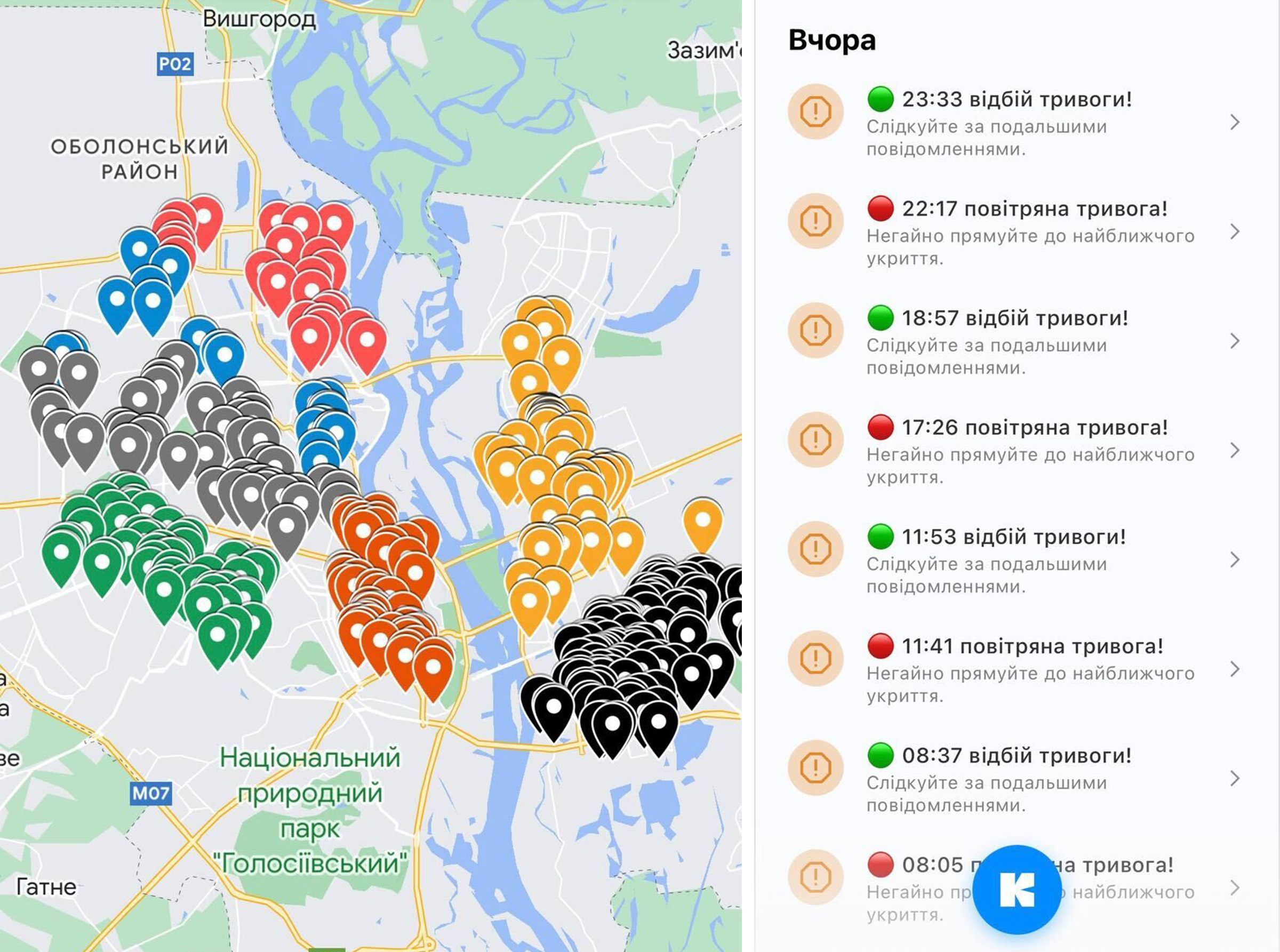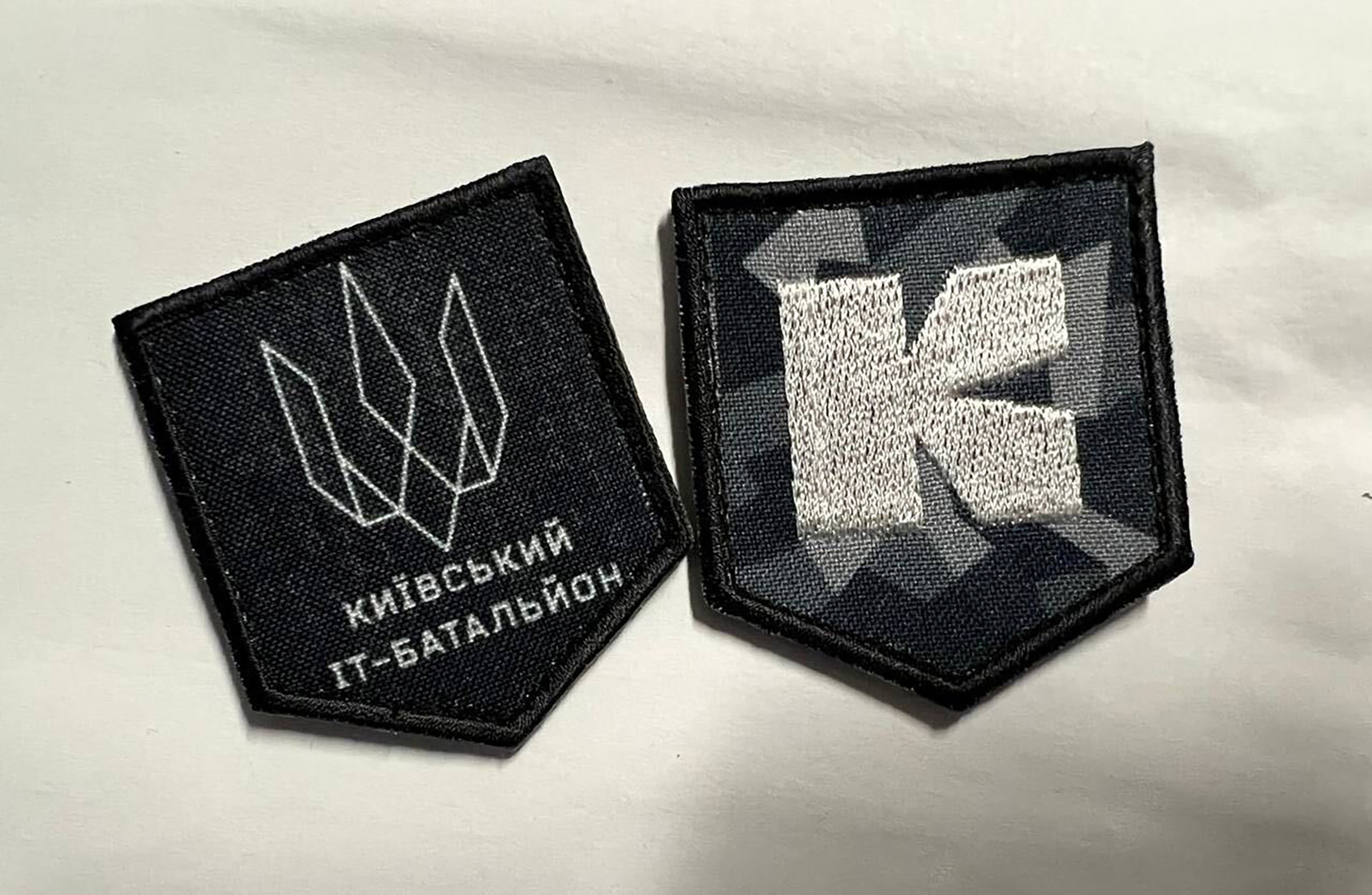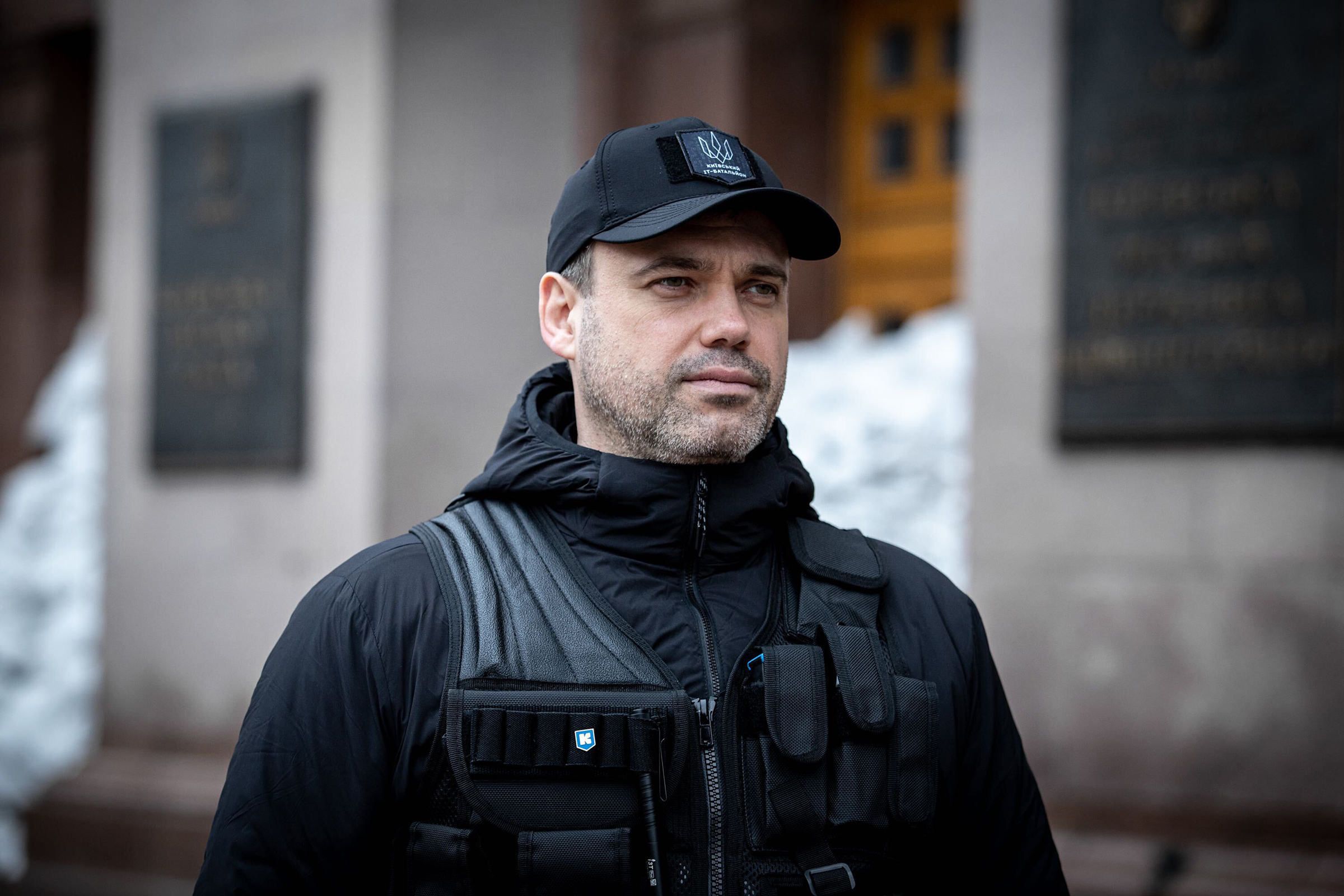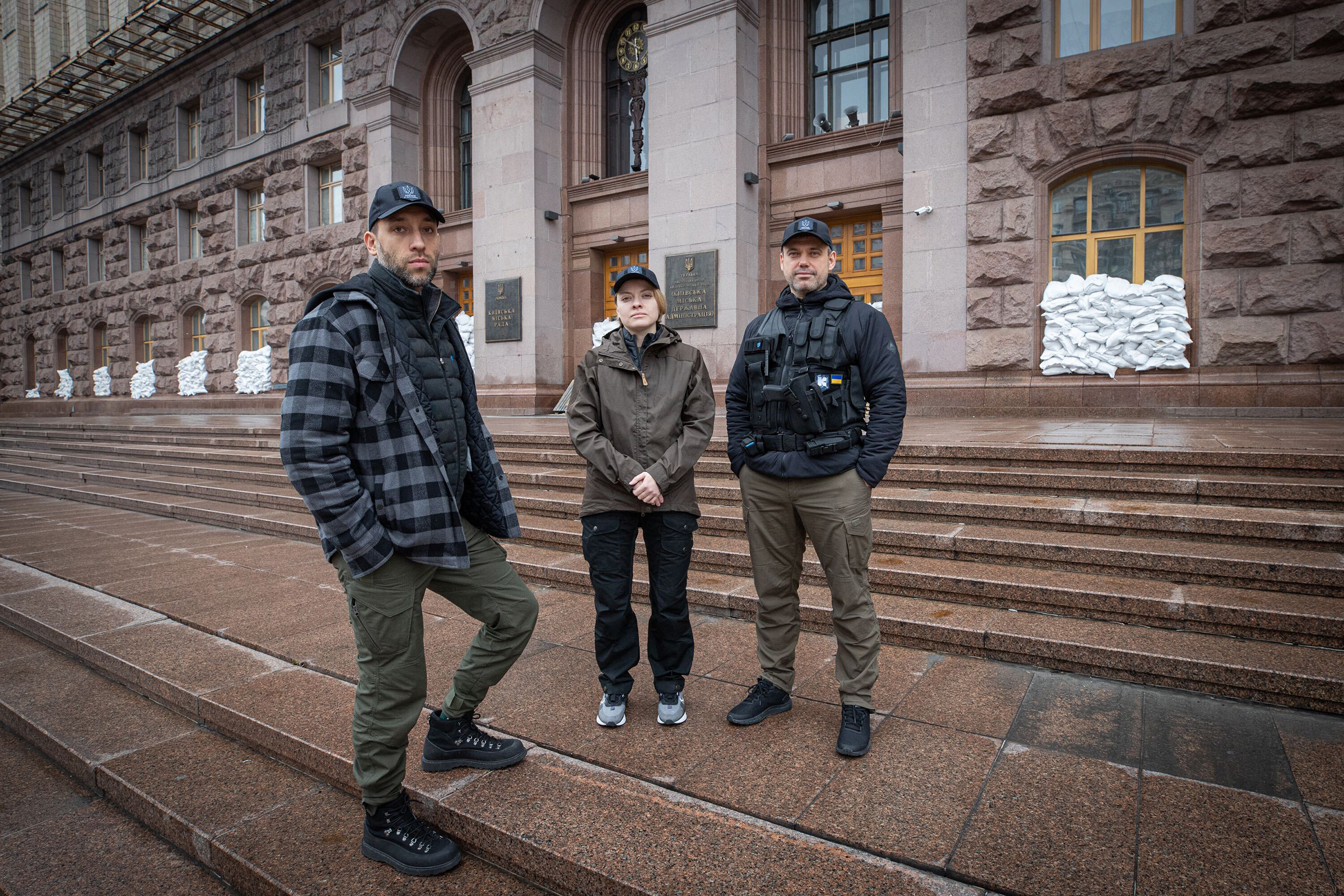When Oleg Polovynko thinks of the first days of the Russian invasion of his country, he looks down at his fitness watch. In normal times, the 38-year-old IT director in Kyiv’s city council used his Garmin watch to track his workouts. “Right now, my heart rate is 62,” he tells TIME, holding up his wrist. “In the first five days after Feb. 24, it was never below 90.”
For the past five weeks, Polovynko and his boss, Kyiv’s deputy mayor and chief digital transformation officer Petro Olenych, have led an exhaustive effort to adapt and repurpose everyday technology for a city that has found itself facing a 20th-century-style war. Their creative maneuvers are a key reason that most residents of the Ukrainian capital can connect to the Internet in underground bomb shelters, find open pharmacies and grocery stores, and go to sleep knowing their phone will alert them of incoming air raids before the physical sirens sound.
While President Volodymyr Zelensky and Ukrainian digital officials have been lauded for their success in galvanizing global support on social media and fending off the Kremlin’s disinformation campaigns, local officials like Olenych and Polovynko have focused on the practical.
“Every day, we wake up and we’re thinking how we can keep people in the city alive and safe,” says Olenych. The popular Kyiv Digital smartphone app, which residents previously used to pay utility bills and parking tickets, now gives them a map of the closest bomb shelters and places to get critical supplies like insulin, food or gasoline. Notifications for the closure of a local metro stop for repairs have given way to warnings of incoming air raids.

Read More: The Man on Ukraine’s Digital Frontline.
Even the app’s logo reflects this shift. What was once a friendly sky-blue “K” for Kyiv has been redesigned into a black-and-gray military camo pattern. Speaking to TIME on a video call from an undisclosed location in the city, Olenych and Polovynko wore patches of the new logo taped to their olive green T-shirts.
It’s hard to grasp that just two months ago, the main problem their city council faced was complaints about traffic jams downtown. Municipal IT employees now carry guns, and only leave their offices to shower and catch a few hours of sleep whenever they can. (Olenych says he’s been sleeping at Polovynko’s house since a bomb landed near his own home.) On the day they spoke to TIME, employees of the city council’s digital office were poring over mobile data to determine how to best ration food for those that remain.
“I felt like I was part of a modern world, where all of these [technologies] were part of our everyday life, and now suddenly we need to use them for such basic purposes, for life or death,” says Polovynko. “I never imagined that I would develop software in 2022 to help people stay alive, to survive things like a missile attack. But of course, we can. And now we’re using all of our IT minds in Ukraine to help our people and our soldiers.”
More from TIME
On Feb. 24, as the invasion began and air raid sirens blared over the city for the first time since World War II, employees of Kyiv’s digital transformation office held a meeting to decide what to do. They quickly agreed that they would not evacuate. A few employees who are mothers of young children left to work from western Ukraine, but the rest would stay in the city.
Over the next few days, Polovynko’s team spent much of its time trying to restore their systems from backups after a wave of cyberattacks knocked out their online services. “After that, we became like a big startup, where you always receive a lot of tasks and you only go to sleep when you are finished,” Polovynko said about his IT team of roughly 20 employees. “Then you wake up and go back to work.”

Read More: A Ukrainian Photographer Documents the Invasion of His Country.
The next step was to add functionality to the city’s smartphone app so that it could warn residents about incoming missile attacks. The Kyiv Digital app, which had launched its most recent version in Jan. 2021, had more than a million users who subscribed to emergency notifications of everything from transit closures to COVID-19 cases. Now they set out to turn this feature into a potentially life-saving early-warning system.
In recent days, there have been 6 to 10 air raid alarms shared by the app per day, according to city officials. A red alarm icon shows the time and the message “Air Warning! Head to the nearest shelter!” It’s followed by a green icon telling residents when the danger had passed, according to screenshots shared with TIME.
For Vira Gryaznova, a 49-year old non-profit worker who lives in Kyiv with her husband and two cats, the app has been a lifeline. Gryaznova doesn’t have a television and finds it hard to hear the physical sirens from her home. “I was not a user of the Kyiv Digital app before the war,” she says. “But I use it now to get information about air raid alerts.”
The chaotic first week of the invasion produced long lines for basic goods, as thousands of residents desperately tried to stock up or flee the city. So Kyiv’s digital office quickly set up online forms that allowed business owners to report if they were able to open. This information was then added to a map on the app showing which grocery stores, pharmacies and gas stations still have supplies. “Our team has readjusted to deliver new valuable services on an everyday basis,” says Victoria Itskovich, who serves as the city’s deputy IT director. “The main thing I’ve learned during this time is that there is no point in striving for the perfect solution. The best product is the one you can launch here and now.”
With residents often sheltering underground and Internet providers frequently being knocked offline, connectivity became one of the most pressing problems. “We realized we would have to spend a lot of time in these bomb shelters and there was nothing prepared for the long term,” Polovynko says.
Olenych, the deputy mayor, reached out to Kyiv’s Internet providers and organized them into a group on a messaging app. Then his office added a feature to the city’s app that allowed residents to request Internet access for their bomb shelters. More than 1,000 bomb shelters throughout the city did so. As of Thursday, city officials estimated that roughly 800 had been provided with a WiFi connection.

City officials took mobile WiFi hotspots from empty offices in Kyiv’s government buildings to use in bomb shelters. They also got a boost from SpaceX founder Elon Musk, who donated Starlink satellite terminals to provide Internet access after a request from Ukraine’s national digital office. In a March 4 photo shared with TIME, Olenych and Polovynko posed with one of Musk’s satellite dishes, flashing a thumbs-up sign.
Read More: How Telegram Became the Digital Battlefield in the Russia-Ukraine War.
Other Western companies have come to their aid as well. Cloudflare, a San Francisco-based cybersecurity firm, offered the Kyiv city council its services for free, helping them to recover and protect from ongoing cyberattacks. “Cloudflare is appalled by the Russian invasion of Ukraine,” spokesperson Laurel Toney told TIME. “Since the run up to the invasion, Cloudflare has worked to protect Ukrainian websites and networks [and] helped Ukrainian government websites come back online while under active cyberattack.”
Kyiv’s digital office has also been working with Ukrainian mobile operators to arrange free roaming coverage for residents, no matter which provider they use. In recent days, they have also worked with providers on grimmer matters, using analytics of mobile users in Kyiv to get an approximate number of how many people are in the city in order to conserve food rations.
“We really were like Alice in Wonderland—we lived in another world, which was peaceful, friendly, and open,” Polovynko says of his work in Kyiv’s digital office before the war. “Now we’re in a new IT age, where we need to put all of our technology minds towards military goals.”
The city’s digital office has divided residents into two groups: those who are staying to fight, and those who are staying because they are old, sick, or have no way to escape. Both are relying on their digital services to keep them safe—and prepared for what may come next.
“Our main focus is to use any options that can help us save lives, to use the technology to first of all to protect our people – and to kill another people,” says Polovynko. “It’s sad, but unfortunately this is the situation we’re now in. We cannot lose. Ukrainians will never, never give up, and you feel it when you’re here in Kyiv, we will really fight to the end.”
More Must-Reads from TIME
- Cybersecurity Experts Are Sounding the Alarm on DOGE
- Meet the 2025 Women of the Year
- The Harsh Truth About Disability Inclusion
- Why Do More Young Adults Have Cancer?
- Colman Domingo Leads With Radical Love
- How to Get Better at Doing Things Alone
- Michelle Zauner Stares Down the Darkness
Write to Vera Bergengruen at vera.bergengruen@time.com
